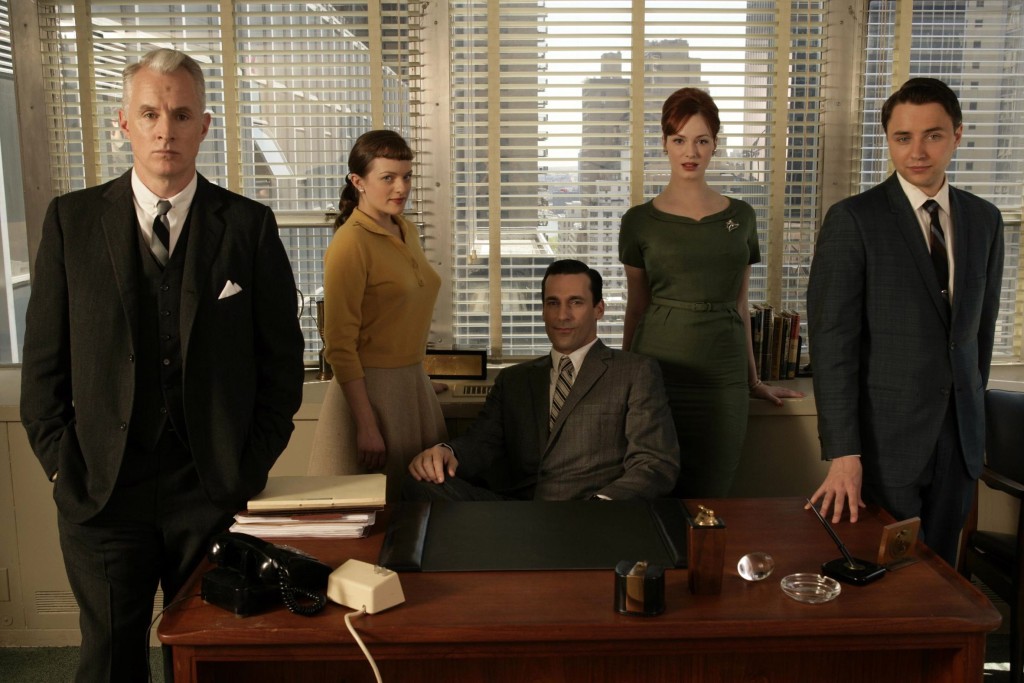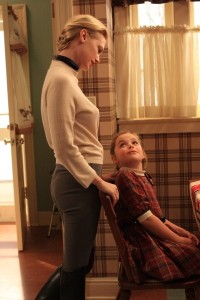Mad Men will begin airing its final episodes on April 5th. Both of us Beans have been fans of the series since it premiered way back in 2007, so we’re going to re-watch one season per week before the final season begins. Each of us will put together their own reflection about what makes each season special, and what aspects stick out on the umpteenth viewing.
For Season One, we decided to concentrate on the pilot episode. Becky will dive into how the costumes instantly establish the personalities and aims of the major female characters. Alex will examine how the pilot’s plot sets up the series’ main themes for the long run.
Becky:
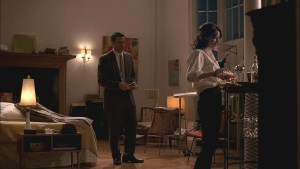
Midge Daniels (Rosemarie DeWitt) is a beatnik living in Greenwich Village having a fling with Don Draper. She is the very first woman we encounter, and is unlike any of the other women that we meet in the first season, subverting everything you’d expect of a woman in 1960. Instead of dressing in an expected outfit – a wiggle dress with structured undergarments or a New Look circle skirt full of crinolines – she wears pants, a stark black and white color palette, a men’s shirt, with a lack of modern undergarments. Seeing her in a simple color palette shows how much she is a blank canvas, always ready to change with the winds.
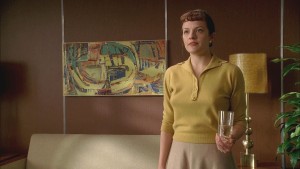 Peggy Olson (Elisabeth Moss) is the new secretary at Sterling Cooper, fresh out of secretarial school. Peggy is fascinating the first time we see her because of the utter lack of interest in her clothing. She shows up wearing a mustard hat and shirt, which will end up becoming her power color throughout the show, the color she wears when she is looking for some luck. We won’t see this color go away from her story until the very end of the most recent season. Her clothes are nothing special. She fails to stand out, disappearing into her environment more often than not. She is not here to make waves, she is here to fit in, keep her head down, and work hard.
Peggy Olson (Elisabeth Moss) is the new secretary at Sterling Cooper, fresh out of secretarial school. Peggy is fascinating the first time we see her because of the utter lack of interest in her clothing. She shows up wearing a mustard hat and shirt, which will end up becoming her power color throughout the show, the color she wears when she is looking for some luck. We won’t see this color go away from her story until the very end of the most recent season. Her clothes are nothing special. She fails to stand out, disappearing into her environment more often than not. She is not here to make waves, she is here to fit in, keep her head down, and work hard.
Another thing that stands out is how conservative her clothing is. Many women at Sterling Cooper are there just until they find a husband and become housewives, and they dress to play up their good side. Peggy is here to work, not to find a husband. Even when she receives lots of comments from her coworkers about dressing in a more revealing fashion, she sticks to her traditional style. She’s keeping her head down around the guys in order to succeed in their professional world.
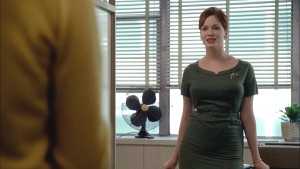 Joan Holloway (Christina Hendricks) is the (possibly self-proclaimed) office manager at Sterling Cooper. Joan dresses to wow each and every time that we see her, which makes her first viewing all the more impactful. Compared to the other women in the office, she is dressed more flamboyantly, in a tighter dress, showing more skin, with her hair is in a fancy updo. (Can you imagine how long it must take her each day to get ready for work? And how would you do any work in those period correct undergarments?) Of all the characters, she knows what style works for her, right up to the colors she wears – the color green signifies wealth and power. While many women are looking for a man to settle down with and take care of them, Joan wants more. She knows how to use her body and clothing to further her career and her independence, not bothering to care about her home life. If she wanted to settle down with a husband, we’d probably see her in baby blues and pink.
Joan Holloway (Christina Hendricks) is the (possibly self-proclaimed) office manager at Sterling Cooper. Joan dresses to wow each and every time that we see her, which makes her first viewing all the more impactful. Compared to the other women in the office, she is dressed more flamboyantly, in a tighter dress, showing more skin, with her hair is in a fancy updo. (Can you imagine how long it must take her each day to get ready for work? And how would you do any work in those period correct undergarments?) Of all the characters, she knows what style works for her, right up to the colors she wears – the color green signifies wealth and power. While many women are looking for a man to settle down with and take care of them, Joan wants more. She knows how to use her body and clothing to further her career and her independence, not bothering to care about her home life. If she wanted to settle down with a husband, we’d probably see her in baby blues and pink.
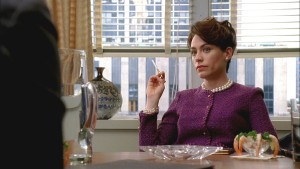 Rachel Menken (Maggie Siff) runs the day-to-day business of her family’s department store, trying to build the company into an elite store, on par with the top 5th Avenue shops. Rachel may very well be my favorite character. From the very first time we see here, she is there to stand out as a woman in a man’s world. Some women might attend a meeting with an ad agency knowing it would all be men, and dress to look as similar to them as possible; Rachel chooses to go the opposite way. She puts on a bright purple suit dress and pearls, the color signifying royalty and the pearls displaying her wealth. Everyone is expecting a man in the meeting (her father), but she shows up in a bold dress, standing out in the sea of dark suits at the meeting. Her dress is a metaphor for everything she wants her store to be, and she isn’t afraid to shake things up to get to where she wants.
Rachel Menken (Maggie Siff) runs the day-to-day business of her family’s department store, trying to build the company into an elite store, on par with the top 5th Avenue shops. Rachel may very well be my favorite character. From the very first time we see here, she is there to stand out as a woman in a man’s world. Some women might attend a meeting with an ad agency knowing it would all be men, and dress to look as similar to them as possible; Rachel chooses to go the opposite way. She puts on a bright purple suit dress and pearls, the color signifying royalty and the pearls displaying her wealth. Everyone is expecting a man in the meeting (her father), but she shows up in a bold dress, standing out in the sea of dark suits at the meeting. Her dress is a metaphor for everything she wants her store to be, and she isn’t afraid to shake things up to get to where she wants.
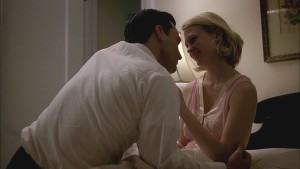 Betty Draper (January Jones) is the wife of Don Draper, who we do not meet until the very end of the first episode. The first time we see Betty, she is in bed sleeping. She is surrounded by all white linens, a white wall and door, and Don’s white dress shirt. On top of that she is wearing a white and soft pink nightgown. Everything about her portrayal here is showing her as innocent and youthful – the image of perfection. Betty’s place in this world is as the perfect housewife, with the white picket fence, two children, and a plate of food always warming in the oven. Even in sleep, she has herself so put together that she looks perfect and heavenly. Obviously, we know that no one looks this perfect when they are asleep, which clues you in to the facade that she feels the need to always be put up – Don might be more wrinkled here than Betty is. She feels the heavy push of society standards and will do whatever is needed to fit into these norms.
Betty Draper (January Jones) is the wife of Don Draper, who we do not meet until the very end of the first episode. The first time we see Betty, she is in bed sleeping. She is surrounded by all white linens, a white wall and door, and Don’s white dress shirt. On top of that she is wearing a white and soft pink nightgown. Everything about her portrayal here is showing her as innocent and youthful – the image of perfection. Betty’s place in this world is as the perfect housewife, with the white picket fence, two children, and a plate of food always warming in the oven. Even in sleep, she has herself so put together that she looks perfect and heavenly. Obviously, we know that no one looks this perfect when they are asleep, which clues you in to the facade that she feels the need to always be put up – Don might be more wrinkled here than Betty is. She feels the heavy push of society standards and will do whatever is needed to fit into these norms.
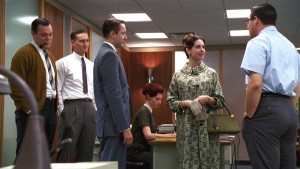 Trudy Campbell (Alison Brie) is the new wife of Pete Campbell, a young account executive. While she is not shown in the first episode, besides a picture on Pete’s desk, her first appearance is still worthy of discussion. The first time we see Trudy, she is surprising her husband at work so they can look for an apartment together. She wears a bold print overcoat and does not look like she fits in around the account men or secretaries in the office. This appearance is right after their honeymoon, and I can’t help but notice how bulky her coat is. It almost looks like she is giving herself room for a pregnant belly. Since she was just married, this is merely wishful thinking, preparing for what she expects in her near future. She is dressing to society’s norms – just like Betty, though at an earlier stage in her life. We also see her standing out from the other women with her matching accessories, including the green bag and white elbow gloves – not a practical outfit for actually working, but for walking around town and being seen.
Trudy Campbell (Alison Brie) is the new wife of Pete Campbell, a young account executive. While she is not shown in the first episode, besides a picture on Pete’s desk, her first appearance is still worthy of discussion. The first time we see Trudy, she is surprising her husband at work so they can look for an apartment together. She wears a bold print overcoat and does not look like she fits in around the account men or secretaries in the office. This appearance is right after their honeymoon, and I can’t help but notice how bulky her coat is. It almost looks like she is giving herself room for a pregnant belly. Since she was just married, this is merely wishful thinking, preparing for what she expects in her near future. She is dressing to society’s norms – just like Betty, though at an earlier stage in her life. We also see her standing out from the other women with her matching accessories, including the green bag and white elbow gloves – not a practical outfit for actually working, but for walking around town and being seen.
Alex:
After reading your thoughts on the costumes, Becky, my mind jumped to the other ways that Season One of Mad Men sets up the rest of the series. I doubt that Matthew Weiner and company had everything planned out from the word go, but the series starts with such a self-assured tone and theme, that it’s hard not to see the future get set up as we start this re-watch.
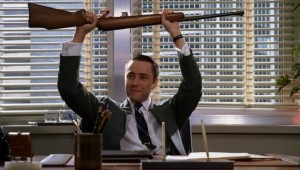
What a tool. Pete’s journey from total asshat to empathetic asshat is one of the show’s great unexpected journeys.
Maybe the best way to show that is to look at the main thematic concern of the series, as well as how that gets set up right in the pilot. Mad Men is, at its core, a show about the eternal conflict between our public and private selves. The show states that who we are in the office is not who we are at home – at least not in this vision of America in the 1960’s. (Are you a different person at work than you are at home, Becky? I doubt it, but then I think a lot of Mad Men characters would say the same.) This has been demonstrated in a ton of ways over the past eight years, but it’s all set in motion in the pilot.
Pete and Peggy start an affair (of sorts – I think they only have sex twice) in this episode when he shows up drunk at her apartment. It’s still Peggy’s first week (maybe even her first day?) at Sterling Cooper, where she has been told repeatedly to look and act sexier at the office. She runs this to its logical conclusion, but is so uncertain about her actions that she keeps the affair private even from her roommate. For his part, Pete’s insistent venality ruined his own bachelor party earlier that night, so he turns to the doe-eyed new secretary out of desperation. Neither of these characters ever make public noise about their dalliance, so from the start we can see delineations between the public and private in Mad Men.
More telling, though, is how the show reveals the truth of Don Draper’s home life to the audience. The entire pilot sets Don up to be one of those businessmen who are so driven that traditional cares like family and morality are set aside – think Jordan Belfort from Wolf of Wall Street. However, when Don rides a suburban commuter train to a tiny Westchester house and wakes his beautiful housewife and kisses his kids goodnight, it is a legitimate “gotcha” moment. Don is more than he seems at first glance, and the series will go on to revel in exploring just how many layers he has. For now, the camera pans out to the tune of “On the Street Where You Live” and we’re left wondering how that brilliant hedonist we saw in Manhattan can have an idyllic suburban family as well. Well, he can’t. But that’s for us to find out as time goes by.

